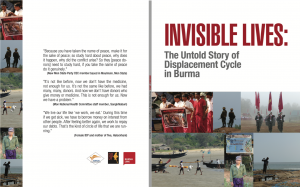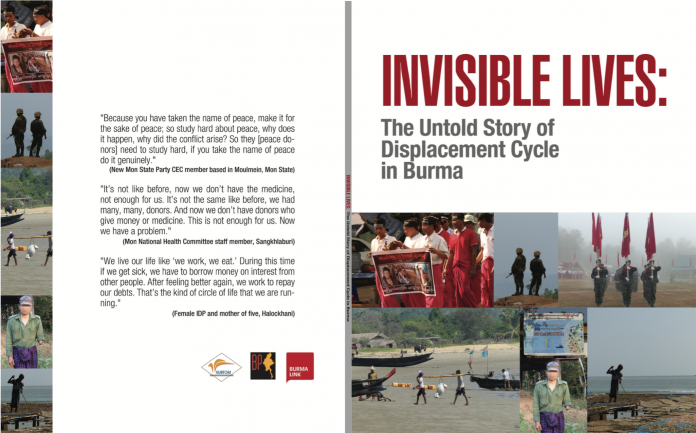Over 35,000 ethnic Mon IDPs living in New Mon State Party (NMSP) territory fear a decline in international aid and financial support, according to a joint report on IDPs released on Monday, in Moulmein, the capital of Mon State.
The Human Rights Foundation of Monland (HURFOM), Burma Link and the Burma Partnership released the report, titled “Invisible Lives: The Untold Story of Displacement Cycle in Burma,” which illustrated that six-plus decades of armed conflict has created the displacement crisis with over 644,000 internally displaced persons (IDPs) and over 479,000 refugees fleeing their homes, especially in ethnic areas. Along the Thai-Burma border, there are currently more than 100,000 refugees residing in camps, and approximately 400,000 IDPs living in protracted displacement throughout the country’s southeast.
“We live our lives. If we work, we eat. During this time, if we get sick, we have to borrow money with interest from other people. After feeling better again, we can work to pay our debts. That’s the kind of circle of life that we are living”, said an IDP from Halockhani camp, as quoted in the report.

As the political and social transformation in Burma continues — following the success of the National League for Democracy (NLD) in the 2015 elections — optimism that IDPs will soon be able to return to Burma has led to further decline in donor funding along the border, according to the report.
“Concerning health care, there are still problems for the IDPs. When there are illnesses that the IDPs have, they have to rush them to Ye Town for medical treatments or across to Thai side for the treatments. However, they have to spend lots of money for the transportation fee and medical care,” said Leena Zieger, International Coordinator of Burma Link.
Zieger continued that IDPs are very concerned with the lack of security, the uncertainty of housing back in Burma and, consequently, they don’t want to go back yet.
The IDPs in the NMSP controlled areas are not only facing a lack of support for health care and educational opportunities, but also a lack of aid, according to Nai Ong Sorn, of New Mon State Party’s Mon Relief and Development Committee.
“In the past, there were IDP repatriation programs but they did not succeed. However, during this new government’s term, we urge them for a clear policy for IDP repatriation in order to be able to provide aid and ensure the program is successful,” said Nai Aue Mon, HURFOM’s Program Director.
Farmers and villagers, in Ye town and Yebyu Township in particular, have been struggling to gain land rights in the past which has further fuelled the displacement crisis. Protecting farming land from the Burmese Army, the government and foreign investment has become an important issue in the repatriation discourse.
In July, 2016, HURFOM released a report titled; “Examining Foreign Direct Investment in Mon State, Burma”. The report commented on the effects of the recent surge of FDI in the country, whilst elaborating on the activities of local people and expressing solidarity with them as they are directly or indirectly affected by the FDI.
The Burma Link, the Burma Partnership and HURFOM also organized a press conference on Friday [August, 12], in Rangoon, launching the IDP report.

